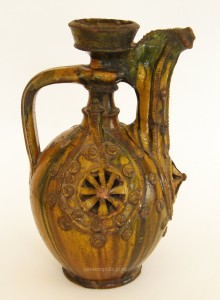Product Description
Christopher Dresser / Linthorpe, Rare Aesthetic Movement “Persian” jug 1879


CHRISTOPHER DRESSER (1834-1904) UK
LINTHORPE ART POTTERY, Middlesbrough
HENRY TOOTH Artistic Manager Linthorpe (1842-1918) UK
“Persian” jug 1879-1882
Glazed earthenware
Marks: LINTHORPE, Chr. Dresser (facsimile signature),
HT, no. 344
Illustrated: Truth, Beauty, Power: Dr. Christopher Dresser 1834-1904, exhibition catalogue Historical Design, Inc. (New York, 1998) p. 76.
H: 8 3/4″
Rare model.
The contrasts in Dresser’s designs for different materials showed how his approach to design was also shaped by the properties and nature of a material. In 1879 Dresser was appointed art director at the newly established Linthorpe pottery, near Middlesbrough. Founded by John Harrison, a local businessman, the pottery’s aim was to use local clay to provide jobs for local men. Dresser’s design for the moulds for the pottery were inspired by a wide range of cultures from Japan, Peru, Mexico, Morocco and Ancient British forms. These very striking pieces, with the metal oxides in the complex and innovative glazes providing the only decoration. All of his designs were impressed with a facsimile signature. When Linthorpe closed in 1889, its moulds were acquired by a rival, Ault Pottery in Derbyshire. In 1893, Dresser signed a contract with Ault for new designs specifying that each pot should be marked with his facsimile signature.
Christopher Dresser / Linthorpe, Rare Aesthetic Movement “Persian” jug 1879
CHRISTOPHER DRESSER (1834-1904) UK
OLD HALL EARTHENWARE CO. (1861-1886) Staffordshire, UK
“Persia Pattern” dinner plate c. 1861-1886
Overall cream gloss glazed octagonal-shaped earthenware dinner plate from the “Persian” pattern with transfer-printed and over-glazed ornate foliate motif; each corner contains two shallow indentations for condiment use.
Marks: Old Hall and Persia Marks
W: 9 15/16″
The identical plate in the “Persia Pattern” can be found in the collection of the Wolfsonian. A soup plate in the identical “Persia Pattern” can be found in the collection of the Brooklyn Museum.
PROF. MICHAEL POWOLNY (1871-1954) Austria
JOH. LÖTZ WITWE GLASWERKS Klostermϋhle, Bohemia
Tall bud vase c. 1914
“Opal mit streifen” opaline blown glass with applied blue glass canes and blue knob above opaline base
Exhibited: 1914 Werkbundausstellung, Cologne (Lötz period photograph, vase for the 1914 Cologne Werkbund Exhibition) Lötz: Böhmisches Glas 1880-1940: Werkmonographie, Band 1, Helmut Ricke and Ernst Ploil (Munich: Prestal-Verlag, 1989), p. 267; Wiener Werkstätte Design in Vienna 1903-1932, Christian Brandstätter (New York:Verlag Harry Abrams, 2003) p. 247.
Form illustrated: Lötz: Böhmisches Glas 1880-1940: Werkmonographie, Band 1, Helmut Ricke and Ernst Ploil (Munich: Prestal-Verlag, 1989), p. 267
Same ”opal mit streifen” technique illustrated: Glaskunst der Moderne: von Josef Hoffmann bis Wilhelm Wagenfeld, Torsten Bröhan (Munich: Klinkhardt & Biermann, 1992), cat. no. 19, pp. 74-77.
H: 11″ x Dia: 3 1/2″
Price: $10,500
